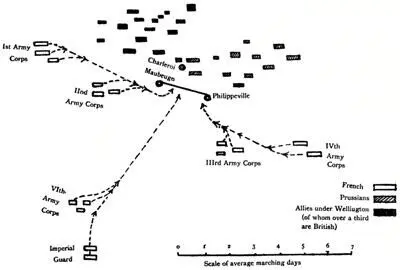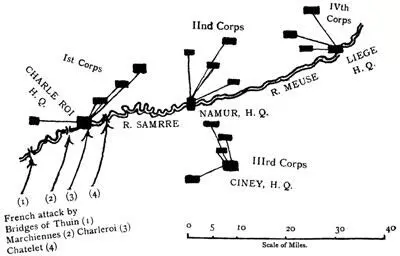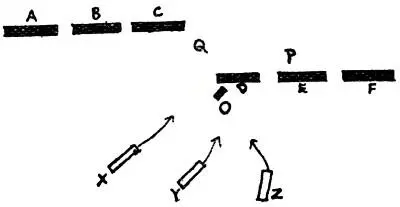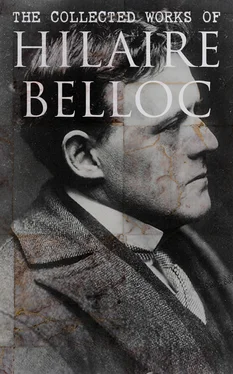The eastern Prussian or left half of the line was, as is apparent in the preceding map, somewhat larger. It had a quarter more men and half as many guns again as that under the Duke of Wellington, and it was organised into four army corps, whose headquarters were respectively Charleroi, Namur, Ciney, and Liège.
The whole line, therefore, which was waiting the advance of Napoleon, was not quite two and a third hundred thousand men, with rather more than 500 guns. Of this grand total of the two halves, Wellington’s and Blucher’s combined, about eighteen per cent. came from the British Islands, and of that eighteen per cent., again, a very large proportion—exactly how large it is impossible to determine—were Irish.
Now let us turn to the army which Napoleon was leading against this line of Wellington and Blucher. It was just under one hundred and a quarter thousand men strong, that is, just over half the total number of its opponents. It had, however, a heavier proportion of guns, which were two-thirds as numerous as those it had to meet.
This “Army of the North” was organised in seven great bodies, unequal in size, but each a unit averaging seventeen odd thousand men. These seven great bodies were the 1st, 2nd, 3rd, 4th Army Corps, the 6th Army Corps, the Imperial Guard, and the reserve cavalry under Grouchy.
The concentration of this army began, as I said in a previous section, upon the 5th of June, and was effected with a rapidity and order which are rightly regarded as a model by all writers upon military science.
The French troops, when the order for concentration was given, stretched westward as far as Lille, eastward as far as Metz, southward as far as Paris, in the neighbourhood of which town was the Imperial Guard. The actual marching of the various units occupied a week. Napoleon was at the front on the night of the 13th of June; the whole army was upon the 14th drawn up upon a line stretched from Maubeuge to Philippeville, and the attack was ready to begin.
The concentration had been effected with singular secrecy, as well as with the promptitude and accuracy we have noted; and though the common opinion of Wellington and Blucher, that Napoleon had no intention of attacking, reposed upon sound general judgment—for the hazard Napoleon was playing in this game of one against two was extreme—nevertheless it is remarkable that both of these great commanders should have been so singularly ignorant of the impending blow. Napoleon himself was actually over the frontier at the moment when Wellington was writing at his ease that he intended to take the offensive at the end of the month, and Blucher, a few days earlier, had expressed the opinion that he might be kept inactive for a whole year, since Bonaparte had no intention of attacking.
By the evening of Wednesday, June the 14th, all was ready for the advance, which was ordered for the next morning.
It would but confuse the general reader to attempt to carry with him through this short account the name and character of each commander, but it is essential to remember one at least—the name of Erlon ; and he should also remember that the corps which Erlon commanded was the First Corps; for, as we shall see, upon Erlon’s wanderings with this First Corps depended the unsatisfactory termination of Ligny, and the subsequent intervention of the Prussians at Waterloo, which decided that action.
It is also of little moment for the purpose of this to retain the names of the places which were the headquarters of each of these corps before the advance began. It is alone important to the reader that he should have a clear picture of the order in which this advance took place, for thus only will he understand both where it struck, and why, with all its rapidity, it suffered from certain shocks or jerks.
Napoleon’s advance was upon three parallel lines and in three main bodies.
The left or westernmost consisted of the First and Second Corps d’Armée; the centre, of the Imperial Guard, together with the Third and Sixth Corps. The third or right consisted of the Fourth Corps alone, with a division of cavalry. These three bodies, when the night of Wednesday the 14th of June fell, lay, the first at Sorle and Leer; the second at Beaumont, and upon the road that runs through it to Charleroi; the third at Philippeville.
It is at this stage advisable to consider why Napoleon had chosen the crossing of the Sambre at Charleroi and the sites immediately to the north on the left bank of that river as the point where he would strike at the long line of the Allies.
Many considerations converged to impose this line of advance upon Napoleon. In the first place, it was his task to cut the line of the Allies in two at the point where the extremity of one army, the Prussian, touched upon the extremity of the other, that of the Duke of Wellington. This point lay due north of the river-crossing he had chosen.
Again, the main road to Brussels was barred by the fortress of Mons, which, though not formidable, had been put in some sort of state of defence.
Again, as a glance at the accompanying map will show, the Prussian half of the allied line was drawn somewhat in front of the other half; and if Napoleon were to attack the enemy in detail, he must strike at the Prussians first. Finally, the line Maubeuge-Philippeville, upon which he concentrated his front, was, upon the whole, the most central position in the long line of his frontier troops, which stretched from Metz to the neighbourhood of the Straits of Dover. Being the most central point, not only with regard to these two extremities, but also with regard to distant Paris, it was the point upon which his concentration could most rapidly be effected.

This, then, was the position upon the night of the 14th. The three great bodies of French troops (much the largest of which was that in the centre) to march at dawn, the light cavalry moving as early as half past two, ahead of the centre, the whole body of which was to march on Charleroi.
The left, that is the First and Second Corps, to cross the Sambre at Thuin, the Abbaye d’Aulne, and Marchiennes. (There were bridges at all three places.) The right or Fourth Corps was also to march on Charleroi. 3
Napoleon intended to be over the river with all his men by the afternoon of the 15th, but, as we shall see, this “bunching” of fully half the advance upon one crossing place caused, not a fatal, but a prejudicial delay. Among other elements in this false calculation was an apparent error on the part of Soult, who blundered in some way which kept the Third Corps with the centre instead of relieving the pressure by sending it over with the Fourth to cross, under the revised instructions, by Châtelet.

Disposition of the Four Prussian Corps on June 15th, 1815.
At dawn, then, the whole front of the French army was moving. It was the dawn of Thursday the 15th of June. By sunset of Sunday all was to be decided.
* * * * *
At this point it is essential to grasp the general scheme of the operations which are about to follow.
Put in its simplest elements and graphically, the whole business began in some such form as is presented in the accompanying sketch map.

Napoleon’s advancing army X Y Z, marching on Thursday, June 15th, strikes at O (which is Charleroi), the centre of the hundred-mile-long line of cantonments A B C——D E F, which form the two armies of the Allies, twice as numerous as his own, but thus dispersed. Just behind Charleroi (O) are a hamlet and a village, called respectively Quatre Bras (Q) and Ligny (P).
Читать дальше















